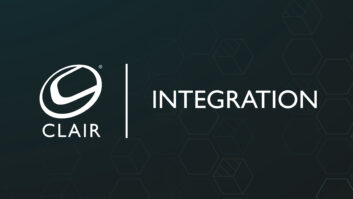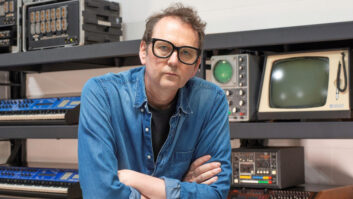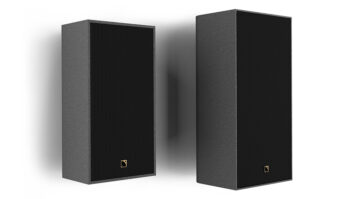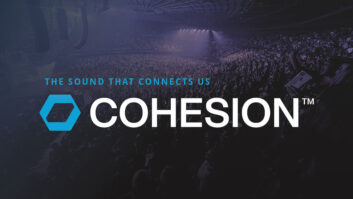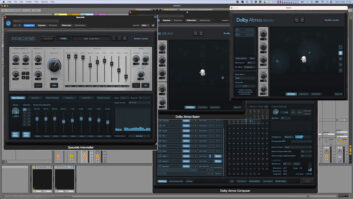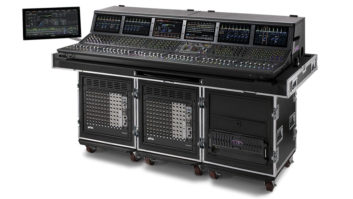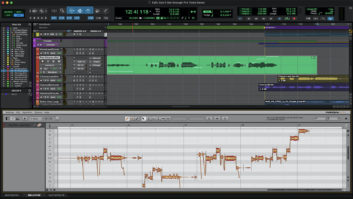
Mixer Glenn Navia (left) and composer/sound designer Andrew Knox in front of one of HSR’s Nuendo systems
Actors’ strike. Economic downturn. Rate-cutting. Big studios closing. If there’s one thing you can count on in the New York post community — no matter the climate, no matter the current market — it’s likely that Howard Schwartz will survive them all. Howard Schwartz Recording alumni have opened and closed countless shops during the more than 25 years that Schwartz has operated above Penn Station.
Like another historical figure, Schwartz has always made a point of stocking his ark with two pieces of any equipment his staff deems necessary. HSR recently took delivery of a pair of computers specifically designed to house Steinberg’s Nuendo. How easily do these DAWs — on a PC and a Mac — integrate with the Fairlight and Pro Tools workstations that HSR owns?
“The audio post business has changed in fundamental ways over the last several years,” says VP and chief engineer Marty Newman. “Networking a variety of digital equipment is a fact of life. It’s no longer about handing someone a piece of tape with a mix on it. Every day we have to take in audio, video and media assets in a variety of file formats. When interoperability works easily, it’s great! When there are problems, we have to solve them quickly. Fortunately, we have tools that let us convert files and make sure the job gets done as easily as possible.
“Glenn Navia, one of our mixers, and Andrew Knox, who works on music and sound design, were both very impressed with Nuendo,” he adds. “Our philosophy is to put tools into the hands of a staff that they feel will help them get the job done to the highest standards.”
Knox installed Nuendo on a 2GHz, dual-processor Mac G5 himself. Once the decision was made to place Nuendo on a PC in the suite Navia uses, HSR started looking around for a vendor. “We wanted to establish a relationship with a company that we felt could handle all installation issues and provide us with good support,” Knox says. “Of course, we could have installed the software and hardware ourselves, but there are a number of manufacturers building audio for video computers and we decided that it would be better to go with one of them.
“Our research told us that the best platform to run Nuendo on is a PC built on an AMD processor,” he continues. “Steinberg put us in touch with the East Coast Music Mall in Connecticut, and we had them put together a system that includes Nuendo. We also had them put Pro Tools LE and [Sonic Foundry] Vegas Video on the workstation. Glenn will basically be using Nuendo to run audio tracks only, so we had Chris Ludwig of the East Coast Music Mall build him a single-processor Athlon workstation. We’ve been very impressed with Ludwig’s knowledge and the service we’ve gotten from the store.”
“I’ve been using Nuendo ever since they came out with Version 1.0,” says Navia, who has been an editor/mixer at HSR for three years. “If I were mixing albums and needed tons of tracks and lots of plug-ins, I’d have to have a dual-processor machine, but I tend to work with about 32 tracks of audio and just a few plug-ins — Waves included — so the single-processor machine that Chris built is fine.
“I also work on a Fairlight,” he says, “and interfacing the two workstations was critical. I had been using analog outputs from the Fairlight, but we recently bought an RME ADI-8 interface that lets me Lightpipe between the two systems. I’m a huge RME fan. Their converters sound great, and for the money, there’s nothing better, in my view.
“We’ve had good results passing OMF files between Nuendo and our Pro Tools and Fairlight stations,” Navia adds. “Nuendo opens OMF files with no problem, but it’s important to have these files prepped properly. The biggest issue that I’ve seen is that when you’re saving an OMF file, you have a series of choices to make, including whether you want the file to be read in .WAV or .AIFF format. You can also choose to have the audio files included in the same folder with the OMF data itself or in a separate file that OMF points to when it’s opened up on the second system. We like to include the audio files with the OMF data in one folder. Otherwise, if one audio file is missing or can’t be easily found for some reason, the OMF session might not open at all. That’s a disaster!
“The A/V transfer program we use handles AES-31 files and I prefer it,” he continues. “It works like an updated version of OMF; fades tend to come out better, for example. But AES-31 hasn’t become the standard yet, so we’ll use it to pass files between systems in house [with the exception of Pro Tools, and OMF to send out and receive files from the outside world.”
Knox has composed music, created sound design and sweetened video at HSR for the past three years. A longtime MOTU Digital Performer user, Knox recently switched over to Nuendo. “Digital Performer is very user-friendly on the MIDI side of things,” says Knox, “but not on the audio side. The opposite is true with Nuendo — at least that’s how I compare the two platforms.
“Nuendo has some features that work perfectly in audio-for-video applications. I particularly like the fact that the user is able to map out different viewing formats in whatever way is most suitable,” Knox continues. “DP and the other digital audio sequencers do give you access to this information, but I think Nuendo has the best interface for viewing various timelines, for example. I like to use VST instruments, and there’s no question that these plug-ins work best with Steinberg software. Sonically, both Nuendo and Digital Performer impress me.
“Being able to integrate different digital equipment, including our two Nuendo workstations, into a seamless whole, without a client’s work process ever being disrupted, is a big challenge,” Knox concludes. “We like to think we’re up to it.”
Gary Eskow is a contributing editor to Mix.

